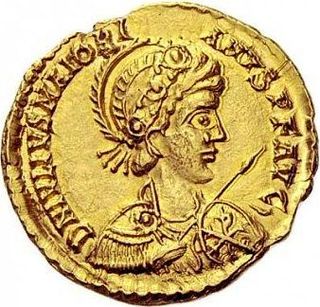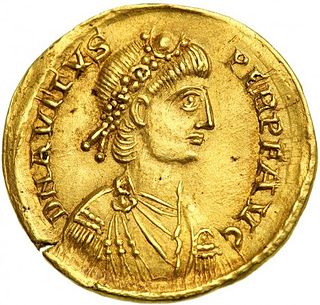History

Aegidius was born in Gaul, a province of the Western Roman Empire. It is believed that he came from the aristocratic Syagrii family, based upon the name of his son, Syagrius. While this evidence is not absolute, modern historians consider a connection to the family likely, by birth or marriage. [1] Aegidius served under Aetius during the latter's time as magister militum (master of soldiers) of the Western Roman Empire. He also served alongside the future emperor Majorian.
Aegidius was either a founding member of Majorian and Ricimer's faction, or else he quickly joined it, [2] wielding considerable influence with Majorian. [3] After Majorian became Western Roman emperor, Aegidius was granted the title magister militum per Gallias in 458 as a reward for his loyalty. [2] [3]
The Ripuarian Franks conquered Cologne and Trier from the Romans c. 457, and Aegidius was besieged in Arles by the Visigoths under King Theodoric II for a time in 457/458, [4] before Majorian defeated him. [5] In the same year, Aegidius led troops at the Battle of Arelate against the Visigoths, [6] where he is credited by ancient sources as being the primary cause for Theodoric II's defeat.
As a result of the battle, Theodoric II was forced to return Visigoth territory in Hispania to the Western Roman Empire and submit again to being a Roman vassal. [7] [8] Aegidius also recaptured Lyons from the Burgundians in 458. [9]
After Ricimer assassinated Emperor Majorian in 461 and replaced him with Libius Severus, Aegidius refused to recognize the new emperor. [10] Libius Severus was not recognized by the Eastern Roman Emperor Leo I, who was considered the senior emperor. Aegidius may have pledged his allegiance directly to Leo I in order to legitimize his independence from the Western Roman Empire, and his retention of the Gallic legions. [11]
Aegidius repeatedly threatened to invade Italy; however, he never did so. Modern historian Penny MacGeorge has suggested that this was due to pressure from the Visigoths, whereas others assert that he was unable or unwilling to march to Italy, leaving Gaul exposed. [12]
Around this time war had broken out Aegidius' lands and the Visigoths, over borders, and Aegidius was said by Priscus to have distinguished himself in the fighting. [3] It is known that during this time, Ricimer ceded Lyons to the Burgundians, and Narbonne and most of Narbonensis Prima to the Visigoths, in exchange for alliances. [13] Ricimer probably appointed a replacement for Aegidius, despite the fact that Aegidius retained most or all of his Gallic forces. The two people most likely to have been given the title of magister militum per Gallias (master of soldiers in Gaul) were the Roman general Agrippinus, whom Aegidius had previously accused of treason, or the Burgundian King Gundioc, who was Ricimer's brother-in-law. [3] [14] Around this time Aegidius sent embassies to the Vandal king Gaiseric, probably in an effort to form an alliance to oppose Ricimer. [15]
According to a story known to Gregory of Tours and the Chronicle of Fredegar , the Frankish King Childeric I, who controlled much of northern Gaul, was exiled at some point after 457, and the Franks then elected Aegidius to rule them. The ancient sources go on to say that Aegidius ruled them for eight years before Childeric was recalled and reinstated as king. This story is considered fictional by most modern historians. [16] [3] Another narrative given by primary sources is that Childeric formed an alliance with Aegidius, although this has slim historical evidence, and is directly opposed by archeological evidence, which supports the theory of the Kingdom of Soissons, the historiographic name given to territory ruled by Aegidius and his son Syagrius, containing the expansion of the Franks. [17] Ernst Stein suggests that the Franks may have placed themselves under Roman rule in the absence of Childeric. [3] [18] Michael Kulikowski posits that his comitatenses (armies) were so heavily Frankish at this point, that he could fairly be remembered as a king, rather than general. [19]
Aegidius repulsed an invasion by the Visigoths in 463, routing them at the Battle of Orleans. [20] In this battle, Aegidius' forces killed the Visigoth general Frederic, who was the brother of Theodoric. Some sources say that Aegidius' forces were bolstered by Frankish forces. [21] [22] [23] Aegidius also won a minor engagement against the Visigoths near Chinon, at an unknown date. [24] Despite these victories, he did not take the offensive against the Visigothic position in Aquitaine, possibly due to lack of resources, [25] or due to threats from comes (count) Paulus, Gundioc, and the Western Roman generals Arbogast and Agrippinus. [26] He sent a diplomatic party to the Visigoths in May 464, which would not return until September of that year. [3]
Aegidius is recorded to have died suddenly, in autumn of 465. [lower-alpha 1] [27] [3] Sources of the time report that he was either ambushed or poisoned, but do not mention a perpetrator. Most modern historians consider it possible that he died a natural death, although some, such as Kulikowski, challenge this. After his death, he was succeeded by his son Syagrius. [3] [28] [19] Syagrius is reported to have moved his seat of government to Soissons, which would later give Aegidius and Syagrius' breakaway government the historiographic name of the Kingdom of Soissons. [29] The Franks defeated Syagrius and captured Soissons in the 480s. [30]














